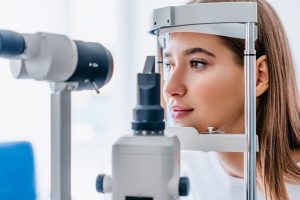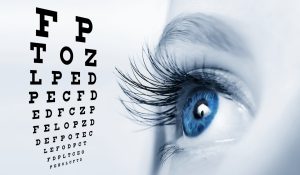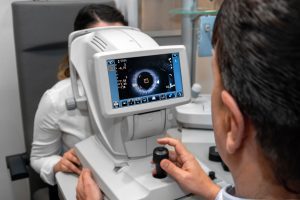Retinal Detachment
WHAT IS RETINAL DETACHMENT?
Retinal detachment occurs when the retina, the thin layer of nerve tissue that lines the back of the eye, becomes separated from its underlying support. Retinal detachment is a serious condition that can lead to long-term vision impairment. If you think that you might have retinal detachment, you should see an eye doctor immediately. There are treatment options to repair damage associated with Retinal Detachment, as well as prevent further damage. Retinal Detachment can be progressive and change quickly, so it is best to be seen as soon as possible if you are having vision problems. Please book an assessment at Louie Eyecare Centre right away. We have access to get in touch directly with emergency retinal centers and can bypass a wait in the emergency rooms. Ocular health exams for these types of conditions are covered by Alberta Health Care for all ages, so there is no charge to the patient for these types of exams. Early diagnosis and treatment are essential for the best possible outcome.
SYMPTOMS OF RETINAL DETACHMENT INCLUDE:
- Sudden onset of floaters (tiny specks or strings in your vision)
- Flashes of light
- A sense that the curtain or veil is being pulled over part of your vision
- Blurred vision in part of your field of view
If you experience any of these symptoms, it’s important to see an eye care professional right away. Retinal detachment can happen suddenly, but it also can progress slowly over time. Sometimes these detachments happen without any symptoms, so it is recommended to have regular eye exams even if you are not noticing any vision or ocular health changes. Yearly eye exams are recommended for those under 19 and over 65, at least every 2 years for those 19-64. There are also certain health conditions that may necessitate more frequent ocular health checks, such as diabetes and hypertension.
WHAT CAUSES RETINAL DETACHMENT?
Retinal detachment is most commonly caused by a break in the retina, called a retinal tear. These tears can occur as a result of trauma to the eye but more commonly occur idiopathically (with no specific cause). Having high myopia (a prescription of -6.00 or higher minus) is associated with higher risk than having a lower prescription or hyperopia (a prescription with + power). In some cases, retinal detachment can be caused by other conditions, such as diabetic retinopathy or uveitis.
If you think that you might be experiencing retinal detachment, you should contact us at Louie Eyecare Centre. We can conduct an eye exam and provide you with treatment options for your condition at no cost, as these types of exams are covered by Alberta Health Care. Book an appointment today.
West Edmonton Vision Clinic
Visit our vision clinic in central West Edmonton for comprehensive eye exams, contact lens fittings, glasses, and more. Louie Eyecare Centre is dedicated to providing the highest quality optometric services and products to our patients. Our team of experienced optometrists is here to help you with all of your eye care needs. Schedule an appointment today!
Clinic Hours
Monday Closed
Tuesday 9:00-5:00
Wednesday 9:00-5:00
Thursday 9:00-5:00
Friday 9:00-5:00
Saturday 9:00-2:00
Closed Sunday / Holidays
OUR CLIENTS' FEEDBACK
Frequently Asked Questions
Wearing glasses or contacts can indeed affect dry eye symptoms, but the impact varies. Glasses can help shield the eyes from environmental factors that exacerbate dry eye, such as wind or air conditioning. On the other hand, contact lenses can sometimes worsen dry eye symptoms by absorbing tear moisture or by causing irritation. Certain types of contact lenses are designed to be more breathable and retain moisture better, which may be suitable for people with dry eyes. It’s crucial to discuss with an eye care professional to find the most appropriate type of contact lens or glasses. Proper care and hygiene when using contacts, along with regular breaks from screen use, can help minimize dry eye symptoms.
Dry eye syndrome can be both a temporary condition and a chronic disease, depending on its cause and severity. Environmental factors or certain life situations, such as screen use or air travel can cause temporary dry eye. Chronic dry eye, on the other hand, may result from systemic diseases, medication side effects, or age-related changes in tear production. Management and treatment can alleviate symptoms, but chronic dry eye often requires ongoing therapy. It’s important to consult with an eye care professional for an accurate diagnosis and treatment plan. Understanding the underlying cause is key to determining whether dry eye syndrome will be a temporary issue or a chronic condition.
Yes, some specific exercises and therapies can help relieve dry eye symptoms. Blinking exercises, for example, can help improve meibomian gland function and tear film stability. Warm compresses applied to the eyes can also stimulate tear production and release oils from the glands in the eyelids. Gentle eyelid massages can help spread the oils evenly across the eye surface, reducing dryness. Using a humidifier to add moisture to the air and taking regular breaks to rest the eyes during screen time can also be beneficial. Newer technologies such as IPL (Intense Pulsed Light) and RF (Radio Frequency) are also becoming available. Consulting with an eye care professional for personalized advice on exercises and therapies is recommended.
Sleep plays a crucial role in managing dry eye syndrome. Poor sleep can lead to insufficient eye lubrication and worsening dry eye symptoms. During sleep, the eyes rejuvenate and produce the moisture needed for the next day. Good sleep hygiene practices can help ensure the eyes are well-rested and hydrated. It’s also important to avoid sleeping with any airflow directly hitting the face, as this can dry out the eyes. Establishing a regular, restful sleep schedule can significantly improve dry eye symptoms.
Indeed, some medications can exacerbate dry eye symptoms. Diuretics, antihistamines, antidepressants, and some blood pressure medications are known to reduce tear production or alter tear composition. It’s important to review any current medications with a healthcare provider to determine if they could be contributing to dry eye symptoms. Sometimes, alternative medications with fewer dry eye side effects can be prescribed. Always consult with a healthcare professional before making changes to medication regimens. Patients should also stay hydrated and consider using artificial tears if taking medications known to cause dryness.
Yes, it is quite common for dry eye symptoms to worsen in certain weather conditions. Dry, windy, or smoky environments can lead to increased tear evaporation, exacerbating symptoms. Conversely, high humidity can sometimes alleviate dry eye symptoms because the air is more saturated with moisture. Cold weather, especially during winter when indoor heaters are used, can also dry out the eyes. It’s advisable to use humidifiers in such conditions to maintain indoor humidity levels. Wearing wraparound glasses or protective eyewear outdoors can help shield eyes from harsh conditions.




